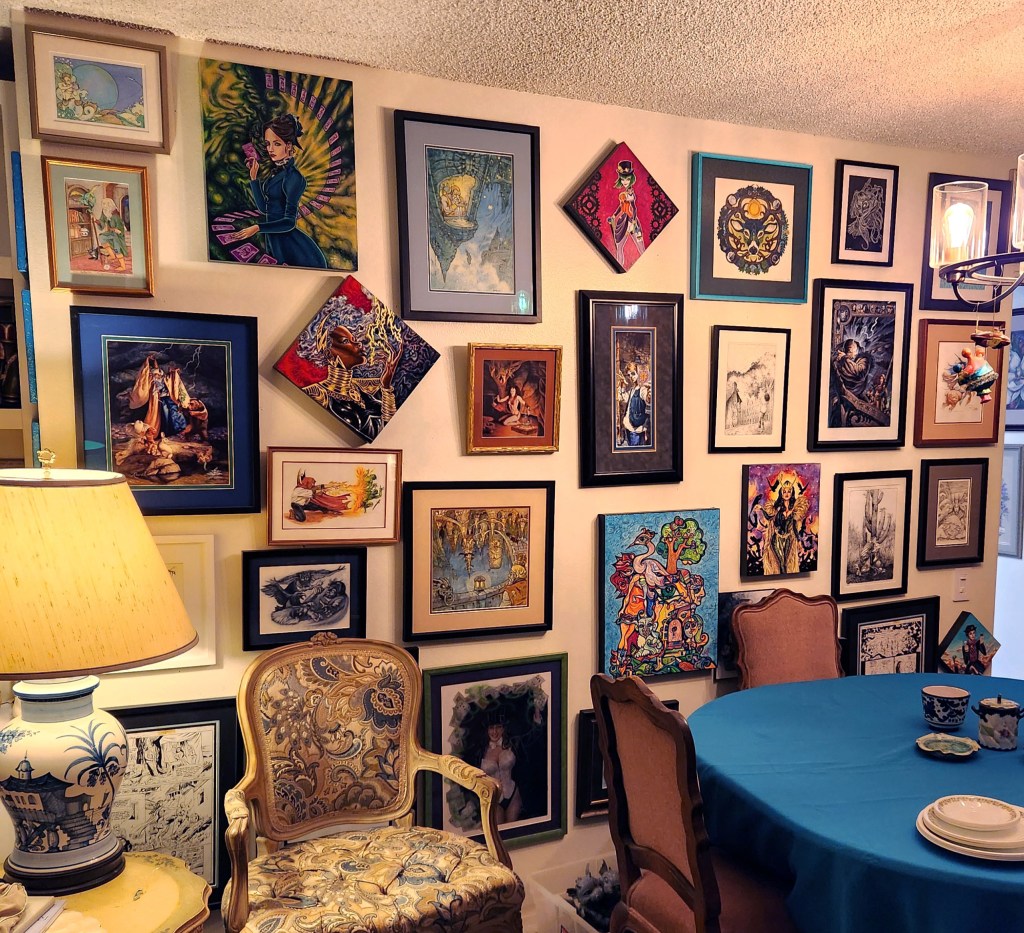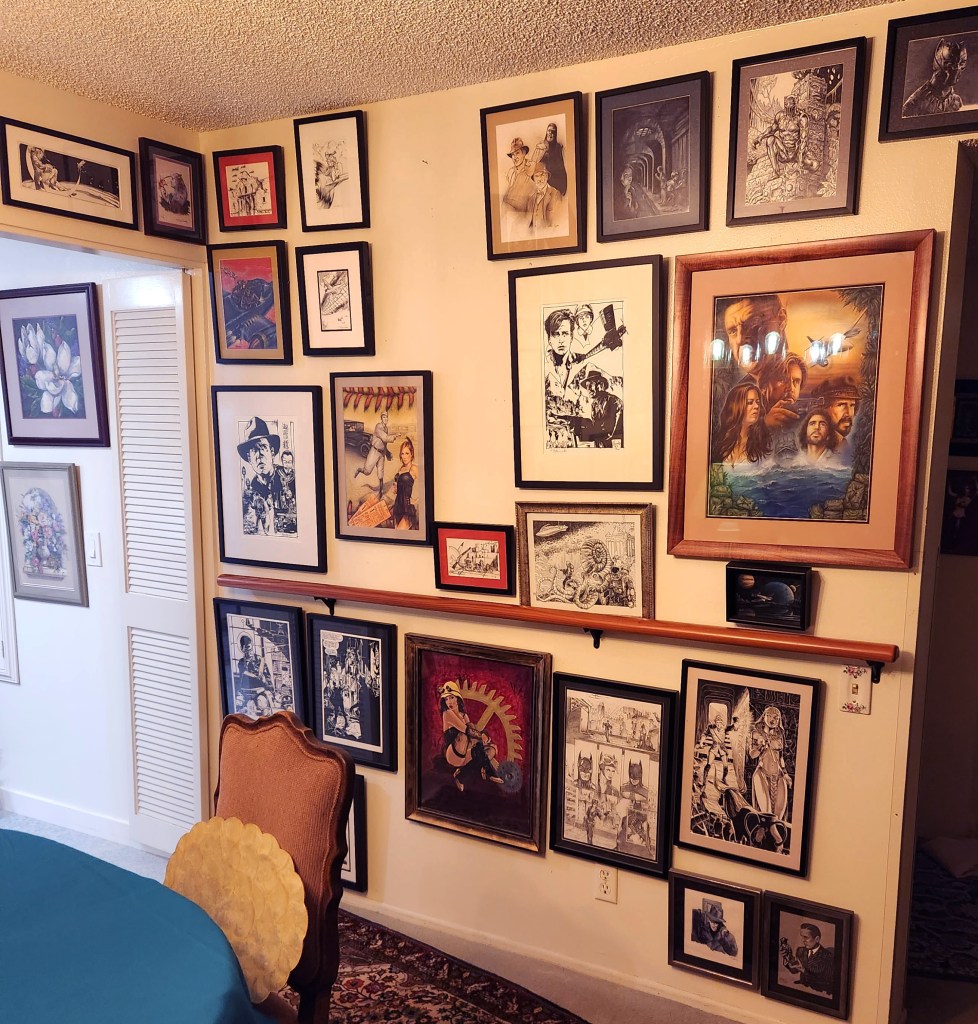
A Collector’s Treasure Trove of Unique Original Comic and Fantasy Art

A Collector’s Treasure Trove of Unique Original Comic and Fantasy Art
The journey of Ron May into the world of comic books is nothing short of fascinating and distinct. Born in the aftermath of World War II, Ron’s foray into comics was inspired by his father, a WWII veteran. His father’s habit of browsing comic books at local stores wasn’t just a hobby; it was a tradition rooted in the camaraderie of soldiers sharing comics to escape the harshness of war momentarily. American soldiers sought solace and a brief escape from the harsh realities of war following the Normandy Invasion by trading comic books in makeshift refuges of collapsed buildings, highlighting the universal need for stories that offer a glimmer of hope and distraction. This piece of history, shared by Ron’s father, sheds light on a lesser-known facet of comic books and their impact.
As he got older, he began to prefer more complex stories. Ron kept his growing collection of comics and enjoyed them over the years. Comics cost increased from 10 cents to over 1 dollar, so Ron stopped buying them regularly. But this made him appreciate the art and storytelling in comics even more. He started attending comic conventions and met artists, including Tommy Lee Edwards, in the early 1990s. Edwards created a piece based on Indiana Jones that resonated with Ron’s archaeology background.
Ron’s interest in art grew into a collection of original pieces, focusing on realistic illustrations and thematic collections that decorated his living space and deepened his connection to art. While framing more pieces, Ron made an unexpected discovery. He noticed a pattern as he laid out the artwork, revealing unintentional thematic centers. This realization led to a reorganization of the display, with dedicated spaces for magic and adventure themes, among others.
Ron’s home transformed into a gallery, with one wall dedicated to magic-themed art and another showcasing adventure, including pieces related to Indiana Jones and artwork from the young Indiana Jones TV show. His Danish heritage influenced a separate collection focusing on Viking and dragon-themed art. Additionally, another area highlighted naïve space art from the 1930s to the ’60s, reflecting the optimistic vision of space exploration during that era.
Over the years, Ron’s focus shifted, leading him to part with his comic book collection. Yet, his passion for art collecting remains unparalleled. His approach to collecting delves into the essence of art, seeking a connection with the art’s history, its creator, and the narrative it encompasses. This transition from focusing solely on the art to understanding the artists behind the works marked a pivotal moment for Ron. He embarked on a journey to uncover the stories of these creators, turning tracking down artists into an adventure, with the San Diego Comic-Con serving as a crucial venue for these discoveries. Despite challenges, Ron’s persistence has allowed him to maintain a presence at the convention since 1976, except for the year disrupted by the COVID-19 pandemic.
Ron’s interest in conventions goes beyond just buying and selling art. He wants to understand what inspires the artists, what stories drive their work, and how their pieces fit into broader cultural narratives. This interest led him to artists like Dan Cooney, who was inspired by classic movies, and Joe Jusko, whose art is highly demanded and valuable. Charles Vess, known for his detailed ink drawings and ability to visually tell captivating stories, is one of Ron’s favorite artists. Ron is passionate about original art, especially pieces that maintain their intricacy and essence before being prepared for publication, showing his belief in the actual value of art. By being selective, Ron has assembled a diverse art collection, each representing one of his interests.
Ron has been collecting art for many years. He started by buying pieces for $40 to $70, but the prices have increased significantly. Some pieces can cost thousands of dollars. Ron is retired now and remembers when $700 or $800 was a lot to spend on a piece. A standout purchase in his collection includes a movie poster by Monte Moore, tied to a film that never saw the light of day, costing him around $800. These days, he usually pays between $100 and $300 on a piece.
The art of negotiation plays a significant role in Ron’s collecting strategy, especially when dealing directly with artists. This helps him get pieces he likes at a happy price. He has never worked out how much his collection is worth because he collects for personal reasons, not to make money. With over 200 pieces adorning the walls of his home and another 150 tucked away in storage, it’s clear that Ron’s collection is not just extensive; it’s a central part of his life.
Ron’s dedication extends beyond acquiring pieces; he’s deeply interested in the artists’ influences and the stories behind their creations. His journey in art collecting is a testament to the profound connection one can have with art, transforming a collection into a narrative of artistic endeavor and appreciation. In the end, Ron May’s story is a compelling narrative about passion, individuality, and the timeless appeal of comic art. It reminds us that in the world of collecting, sometimes the most valuable treasures are those that connect with us on a personal level, transcending the fleeting trends of popular culture.



About Collectibles Insurance Services
Collectibles Insurance Services has been protecting collections since 1966 and all coverage is provided by a carrier with a group rating of “A” (Excellent) by AM Best, the leading rating agency for the insurance industry.
Comprehensive coverage includes, but is not limited to: accidental breakage, burglary, fire, flood, loss in the mail, theft, natural disasters, and other causes of loss unless specifically excluded from the policy. Deductibles start at $0 for collector policies and we provide coverage for the market value of your collection for losses in excess of $50.
Additionally the protection extends At home and away, and we don't require collection itemization and serial number nor extensive paperwork and red tape.
